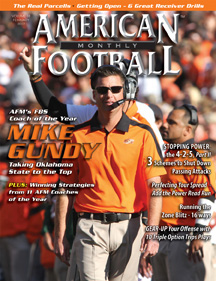Article CategoriesAFM Magazine
|
When and Why to Zone Blitzby: Shaun WeaverDefensive Coordinator and Linebackers Coach, Gettysburg College © More from this issue There are many types of zone blitzes. For this article, the focus will be on the 3 under, 3- deep zone blitz scheme that is widely used across at all levels. When looking at zone blitzing, you must first decide your philosophy on pressure vs. both the run and pass game. These blitzes can be equally effective in attacking the run and pass. An effective zone blitz package will use any second or third-level player as part of the pressure options. At Gettysburg, we have calls that allow both 5-and 6-man pressures with the 3-under, 3-deep coverage behind the pressure. In a 6-man concept, a DE or DT must drop out to an underneath coverage responsibility when pass shows. When to use the zone blitz is always a vital question in your defensive game plan. You must first break your blitzes into run and pass blitzes. Be specific to what ....The full article can only be seen by subscribers.
|
|
|||||||
| HOME |
MAGAZINE |
SUBSCRIBE | ONLINE COLUMNISTS | COACHING VIDEOS |
Copyright 2026, AmericanFootballMonthly.com
All Rights Reserved





